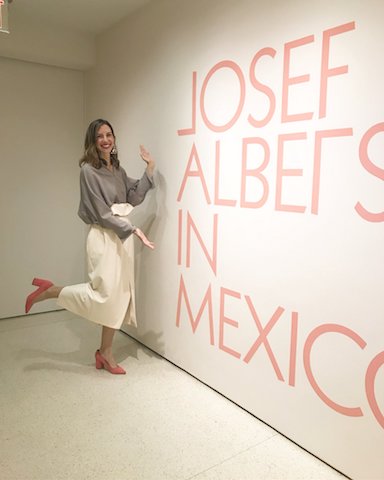
Photo of Lauren Hinkson.
The Heard Museum’s newest exhibition, the “Josef Albers in Mexico” show, is an ode to the vibrant and brightly-colored abstract works of Mr. Albers, himself. Though Albers was a masterful artist, most notably known for his unique perceptions of art and the charismatic pieces that he created, he also inherited a unique appreciation for the world in which he lived in and traveled. The show provides an insight into the unparalleled mind of one of the world’s greatest abstract artists and offers a unique perspective on the country of Mexico – as seen through Albers’ creative lenses, of course.
The heart of this exhibition, though, is found in Lauren Hinkson – the Associate Curator of Collections at the Guggenheim – who has served as an advocate for the show since its inception. The exhibition was born at the Guggenheim Museum in New York and has now found another short-term home at the Heard Museum. We had the opportunity to talk with Hinkson about the power of art, the work that went into bringing this remarkable show to life, and how she’s using her position to bring attention to the hidden works and legacies of lesser-known artists.
AFM: So, for our readership who might not know much about Josef Albers or about his exhibit [Josef Albers in Mexico] at the Heard Museum, can you give a little bit of background about the show and the significance of it?
LH: Sure. So, this is the exhibition’s third stop in a tour. The exhibition originated at the Guggenheim in New York, where I presented it at our museum here. And then it traveled to Venice. And the final stop is the Heard Museum in Phoenix. We thought it would be a great exhibition for audiences in Phoenix who kind of know modern art, those who may have traveled to Mexico or who maybe have never even heard of Josef Albers – they’ll all be able to learn more through the exhibition in a very unique way, both through the photographs and paintings. There’s some brightly colored landscapes – it’s just a really multifaceted exhibition. So, there’s a lot of different ways to engage with the material in view. So, the exhibition is of course looking at the modern master Josef Albers, whose kind of one of the twentieth centuries most important thinkers. And what we’re showing in this exhibition is about one hundred works – which are comprised of about 30 paintings and the rest of the work is photo collages and works of papers. Everything in the exhibition was made between the 1930’s and the 1970’s, and reflects Josef Albers’ interest in Mexico.
So, what we’re seeing in this show is the influence of Albers’ encounters with pre-Columbian monuments on his travels to Mexico. He and his wife, Annie Albers, took a car trip – that took many, many days and sometimes weeks [laughs] – from North Carolina, where they were both teaching at Black Mountain College. They then went down to Mexico. When they first got to Mexico, they wanted to see the ruins throughout the country. They took over a dozen trips between the 1930’s and the 1960’s. Josef photographed sites likes Teotihuacan and so many more. He went to all of these different sites, took photos of the ruins and essentially collaged these pictures together and made these little works of art, that really developed into abstract art pieces. The exhibition really proposes this relationship between his encounters in Mexico and what we come to know Josef Albers for later on in the 50’s and 60’s through his adobe paintings. So, it’s kind of a revision of the origin story of his ideas about abstract art and kind of placing it in Mexico.
AFM: As you mentioned, this is the exhibition’s third stop in the tour. How excited are you to showcase this exhibit to Phoenix audiences at the Heard Museum?
LH: We’re so excited about having it at the Heard, specifically, because it really illuminates the kind of influence of indigenous cultures on art, and of course, that’s the Heard’s mission. In their case, they’re representing Native American art, but any indigenous cultures of their America’s had a profound influence on modern art. So, this is kind of an opportunity to look at that and unpack it a little bit in the context of this important artist. It’s really exciting because in New York, we live in a very different landscape compared to Phoenix. With that, there’s a real connection to place in the show and especially to ideas of color and light and the landscape. You can feel all of that when you’re in Phoenix, because you can see the horizon line and you have this incredible light in Phoenix – and it’s something that you can really feel in the work. So, I think that’s a very powerful, kind of resonating experience for visitors to the show. There’s this great idea of intersectionality that the director is trying to put forth, so we’re really excited to have it at the Heard Museum.
